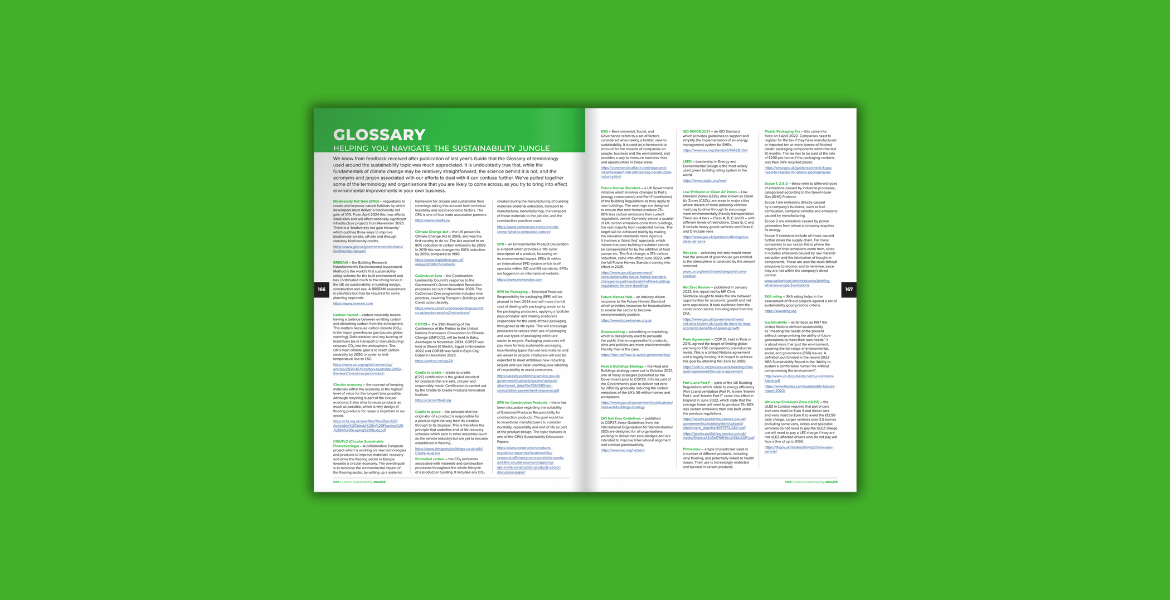
It is undoubtedly true that, while the fundamentals of climate change may be relatively straightforward, the science behind it is not, and the acronyms and jargon associated with our efforts to deal with it can confuse further. The CFA Guide to Sustainability pulls together some of the terminology and organisations that you are likely to come across, as you try to bring into effect environmental improvements in your own business. Here are just some of the key terms you might need to know:
Biodiversity Net Gain (BNG) – regulations to create and improve natural habitats by which developers must deliver a biodiversity net gain of 10%. From April 2024 this now affects small sites and will affect nationally significant infrastructure projects from November 2025. There is a ‘biodiversity net gain hierarchy’ which outlines three ways to improve biodiversity on-site, off-site and through statutory biodiversity credits.
https://www.gov.uk/government/collections/biodiversity-net-gain
BREEAM – the Building Research Establishment’s Environmental Assessment Method is the world’s first sustainability rating scheme for the built environment and has contributed much to the strong focus in the UK on sustainability in building design, construction and use. A BREEAM assessment is voluntary but may be required for some planning approvals.
www.breeam.com
Carbon neutral – carbon neutrality means having a balance between emitting carbon and absorbing carbon from the atmosphere. This matters because carbon dioxide (CO₂) is the major greenhouse gas (causes global warming). Deforestation and any burning of fossil fuels (as in transport or manufacturing) releases CO₂ into the atmosphere. The UN’s main climate goal is to reach carbon neutrality by 2050, in order to limit temperature rise to 1.5C.
www.un.org/sg/en/content/sg/articles/2020-12-11/carbon-neutrality-2050-the-world’s-most-urgent-mission
Circular economy – the concept of keeping materials within the economy at the highest level of value for the longest time possible. Although recycling is part of the circular economy, it also aims to reuse products as much as possible, which is why design of flooring products for reuse is important in our sector.
https://cfa.org.uk/userfiles/files/Zero%20Avoidable%20Waste%20in%20Flooring%20-%20A%20Scoping%20Study.pdf
CISUFLO (Circular Sustainable Floorcoverings) – a collaborative European project which is working on new technologies and products to improve materials’ recovery and drive the flooring sector in Europe towards a circular economy. The overall goal is to minimise the environmental impact of the flooring sector, by setting up a systemic framework for circular and sustainable floor coverings taking into account both technical feasibility and socio-economic factors. The CFA is one of four trade association partners.
www.cisuflo.eu
Cradle to cradle – cradle to cradle (C2C) certification is the global standard for products that are safe, circular and responsibly made. Certification is carried out by the Cradle to Cradle Products Innovation Institute.
https://en.wikipedia.org/wiki/Cradle-to-cradle_design
Cradle to grave – the principle that the originator of a product is responsible for a product right the way from its creation through to its disposal. This is therefore the principle that underlies end of life recovery schemes which exist in other industries (such as the vehicle industry) but are yet to become established in flooring.
www.designingbuildings.co.uk/wiki/Cradle-to-grave
EPD – an Environmental Product Declaration is a report which provides a ‘life cycle’ description of a product, focussing on its environmental impact. EPDs fit within an international EPD system which itself operates within ISO and EN standards. EPDs are logged on an international website.
www.environdec.com
ISO 50005:2021 – an ISO Standard which provides guidelines to support and simplify the implementation of an energy management system for SMEs.
https://www.iso.org/standard/76428.html
LEED – Leadership in Energy and Environmental Design is the most widely used green building rating system in the world.
www.usgbc.org/leed
Scope 1, 2 & 3 – these refer to different types of emissions caused by industrial processes, categorised according to the Greenhouse Gas (GHG) Protocol. Scope 1 are emissions directly caused by a company’s business, such as fuel combustion, company vehicles and emissions caused by manufacturing. Scope 2 are emissions caused by power generators from whom a company acquires its energy. Scope 3 emissions include all those caused further down the supply chain. For many companies in our sector this is where the majority of their emissions come from, since it includes emissions caused by raw material extraction and the fabrication of bought-in components. These are also the most difficult emissions to monitor and to minimise, since they are not within the company’s direct control.www.carbontrust.com/resources/briefing-what-are-scope-3-emissions
SKA rating – a Royal Institute of Chartered Surveyors (RICS) environmental assessment method, benchmark and standard for non-domestic fit outs.
https://www.rics.org/uk/about-rics/responsible-business/ska-rating/
For the full list of terms, visit the Sustainability Glossary in the CFA Guide to Sustainability 2024-2025.